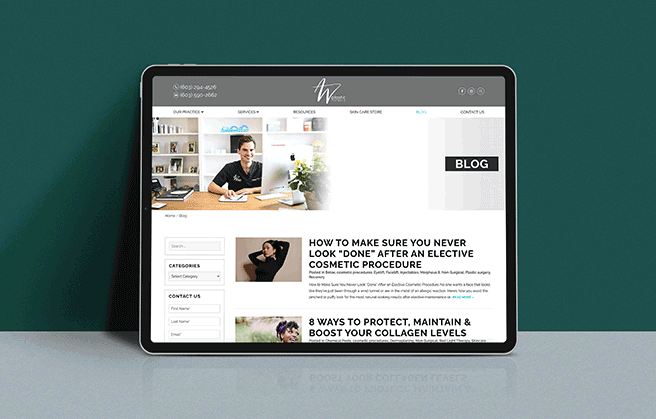High-quality, well-written, informative, and purposeful blog content is like going fishing with the best bait imaginable. Not only are you going to attract more fish to your line (yes, an analogy for visitors to your website), but they’re going to stick around, do some exploring, try a few nibbles until you eventually hook ’em (read: convert).
However, blog content that is lacking a focus, overly-promotional, and outright uninspiring will do just the opposite – not motivate those who come across it to take any further action. Picture it like fishing with spoiled or the wrong kind of bait. Users are going to quickly bounce from the post once they realize it’s not giving them what they need. And when their desire to hang around goes out the window, so does any possibility for a path to conversion.
So how do you give them that delicious bait they so crave? You work on upgrading your blog content. It’s something that AW Plastic Surgery in Portsmouth, New Hampshire, knew they needed when they started working with Hawthorn Creative to improve their overall website visibility, user-experience, and conversion rate. While our work with the boutique practice has included restructuring their website to make it more user friendly (also improving their path to conversion), search marketing (including on-page SEO and ongoing SEO to bring more traffic in), as well as organic social media management, in this particular post, we’re going to look at their blog performance in particular – and how re-strategizing vastly improved the amount of “contact us now” clicks they saw.
First Off, Why Does Blog Content Even Matter?
After all, isn’t having a company website with a strong homepage enough? Yes, while your homepage is probably the most visited page on your website (in fact for majority of websites, the homepage typically receives more than 50% of all visitor traffic), it’s usually various blog posts that make up the other core points of entry through search engines. Essentially, the more blog content you have and continually add, the more opportunity for your company to show up in search engines and drive traffic to your website in organic search – that means more visibility. (Not to mention, Google recognizes the frequent posting of quality content and rewards it with higher search rankings).
SOLUTION
Take Your Content Strategy into the Stratosphere
Content marketing is the engine powering all of your digital channels – without it, you’re going nowhere
So How Do You Create Blog Content that Converts Traffic into Leads?
In the case of AW Plastic Surgery, they had a previous blog managed by another agency that was producing regular posts. And, they were actually seeing a good amount of traffic. But when it came to conversion, the issue didn’t live in the traffic; it was the bounce rates, time spent on page, pages per session, and average time per session – they were too low, a sign of low-engagement that was a result of dry copy, lack of CTAs, or links to additional blog posts to read.
After taking over the management of AW’s blog content in July (where an on-staff content writer with a background in journalism and years of writing for the web began cranking out new monthly blog posts for the brand), by November, we were able to already see a vast improvement in our new content versus the previous content created by the past agency. Our newer posts were showing these key indications:
- A Lower Bounce Rate – On average, a bounce rate of 60.4% versus the previous agency’s 92.2%.
- Users Exploring More Pages Per Session – On average, 1.78 pages per session versus the previous agency’s 1.13.
- Higher Overall Session Time – On average, a session duration of 1:20 versus the previous agency’s 0:29.
This meant that, after entering the site via our blog posts, users were engaging and exploring more of our client’s site over longer periods of time more often than they were through these previous posts produced by the former agency. It also showed that, in that same span of time (July through November), our content was producing more conversions (which, in this case, was someone eventually filling out the “contact us” form after initially landing on the website from one of our blog posts).
So How Did We Do It?

To be honest, the previous agency had good subject potential and keyword research (which is why their posts do see a good amount of traffic), but it lacked the following four critical elements that make for good content that engages a user for a longer period of time and encourages them to spend more time exploring the overall site:
1. Copy that Sets Up AW as the Authority
While the past agency worked with AW to develop the blog’s content angles, they didn’t actually interview anyone at the practice before writing. They simply researched the subject and wrote it, sending the content to Dr. Anthony Wilson to review and edit prior to posting.
“I used to have to do a lot of rewriting,” says Dr. Wilson. “I don’t do that with Hawthorn. Their writers and editors are skilled, taking the time to personally communicate with either myself or the correct member of my team to truly understand the treatment we’re talking about – from surgery to skincare – and the target audience. The results are well-crafted, purposeful material well worth the investment.”
For example, on-staff experts are always quoted in the content, like in this post “Your Essential Fall Skincare Checklist” featuring direct insight from Tracy Thaden, a clinical aesthetician and medical assistant at the practice. Not only does this approach put a face to the very staff potential patients would be interacting with at AW, but it builds the entire practice as a trusted interpreter to digest and distill the latest trends for them – and that’s key to keeping them coming back.
2. Well-Written Engaging Copy
Since AW is a practice offering cosmetic surgeries as well as non-invasive treatments, to some degree, you can expect the copy to read a little “medical.” And while that’s certainly okay, it doesn’t mean you can’t add some flavor to the content, particularly to the headlines, excerpt, and intro.
See an example of one of our posts, “How to Get Rid of Jowls: 4 Treatments for 4 Stages of Sagging” versus an older post like “Why Are Women Electing Smaller Breast Implants?” We’re selecting these two posts in particular because, across the timeframe of September (when our post first went live) to the end of October, both of these posts saw roughly the same amount of sessions. However, our post saw an average bounce rate of 59%, 2.48 pages per session, and session duration of 1:27, while the other saw an average bounce rate of 86%, 1.23 pages per session, and session duration of 0:16. Our post also earned AW three conversions in this time frame, while the other saw 0.
3. Blog CTAs (Call to Action)
Within all of our posts, we design and include a “button” that, using snappy copy, instructs a user to take a certain desired action – i.e. read more about Dr. Anthony Wilson on the About page like in this post or book a consult related to the topic like in this post. The previous content did not, therefore, missed out on a vital opportunity to encourage users to engage with other parts of the website.
MORE INSIGHTS
5 Tips for Writing Irresistible CTAs
Meet the bit of copy that is one of the most important elements in a business’s digital marketing arsenal.
4. In-Text Links and Concluding “Additional Reading” Section
Similar to the concept above, if you want users to stay on your website and look around, you’ve got to give them the means to do so. Therefore, wherever it makes sense, we always include text links to other sections on the website (i.e. if we mention a skincare product or a service, we link to where you can find more info about it under the skincare store page or services pages). Lastly, at the end of each article, we always provide a list of “related reading,” essentially three additional articles in a similar vein to encourage a reader to keep reading.
Next Up: We Refresh Their Older Content
But, when it comes to these previous agency’s posts, we’re not throwing the baby out with the bathwater, of course. After all, many of these posts had good angles and subject potential that were clearly drawing readers in through organic traffic. So, in addition to continuing to generate new blog content, we are also revising/refreshing AW’s older pieces of blog content with higher traffic/pageviews, but lower engagement. That way, we can ensure that readers are truly getting the informative read that they want, while AW – a leading medical aesthetic practice on the New Hampshire seacoast – continues to get the leads that they deserve.
Does all the above sound great, but you’re not sure how to put it into action (nor have the time)?
Our team of designers, writers, and strategists are at your digital disposal. Just drop us a line any time.


